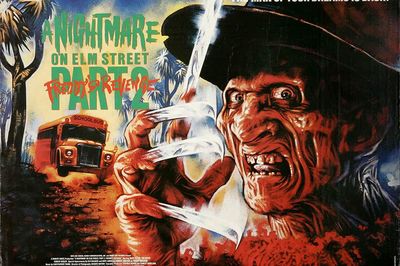Even if they didn’t bust out their slurs of choice, there was always something about the way people responded to A Nightmare on Elm Street 2: Freddy’s Revenge. It was a distinctive sequel, having to pull off the arcane alchemy that transforms a genre concept from a successful one-off into a franchise. And the departure of series creator Wes Craven left things in a weird stasis. So Director Jack Sholder (The Hidden, Alone in the Dark (the good one)) and Screenwriter David Chaskin changed things up. The sweater-clad child killer could slip between dream and reality. The day-to-day of the American high school student became a surreal, primal space. And instead of a Final Girl, the audience surrogate was a teenage boy, coded queer in as brazen a fashion as 1985 would pretend to tolerate.
The film is having a moment right now. Star Mark Patton’s documentary Scream, Queen! My Nightmare On Elm Street, detailing the complicated legacy of Elm Street 2, as well as his own story as an actor in and out of the closet in ‘80s Hollywood during the midst of the plague years, is the hot ticket at film festivals all over the world. We’ve reached a point in which films about queer youth (Booksmart, Love, Simon, and Alex Strangelove to name a few) are being made for, and are reaching, a mainstream audience. Horror films are intersectional buffets of countless perspectives and points of view being represented, and so there’s something gratifying about the strands of fate pulling taut and bringing this movie into our collective brain.
If you’ve never seen A Nightmare on Elm Street 2, you absolutely should. It’s a good slasher, imaginative in its set-pieces, and filled with seven great endearing performances. Imagine a Friday the 13th with seven Betsy Palmers, if you even can. As far as the concepts that the market and audiences demanded of any horror film of the time, it fulfills them and then some. But it’s in the script’s queer content that the legacy of this film gets complicated.
At various times over the intervening thirty-four years, Chaskin has said that the film was intended as a homophobic text to scare gay viewers straight, that there was never any queer content at all and that it was Patton’s uncontainable homosexuality that rewrote the film’s cinematic DNA, and that there was meant to be queer subtext in order to distinguish it from every other film at the time. As his appearance in Scream, Queen! demonstrates, Chaskin has through the years been that messy bitch who loves drama.
But the film leaps past all the behind the scenes messiness to emerge, and remain, an essential queer text. Beyond Mark Patton’s noble, relatable Jesse, we have Robert Rusler’s Grady, who starts out as a bully but reveals a secret emotional life on the edges of the film as his friendship with Jesse humanizes and ultimately civilizes him. (He also gets the film’s funniest line.) We have Marshall Bell as Coach Schneider, whose Dom Daddy realness and gym of many implements have led to several different lines of porn throughout the years, all pitched around the way that teenage trauma has to get worked out through adult flesh. Kim Myers, who is delightful as Lisa Webber/Poletti, Jesse’s ‘girlfriend,’ is a kind and goodhearted young woman who handles the pivot from sexual frustration to supportive ally the best way any young gay boy could hope for. And Robert Englund’s Freddy Krueger is stellar in this, the last time he was allowed to be scary before the jokes started seeping in.
This is a movie whose vision of heterosexual teenage debauchery is scored to a Bobby O song. It is an incoherent text, at war with itself on multiple levels, and its rough edges are one of the aspects that have helped it to gain relevance over the years. There’s no equivalent to it in the Friday the 13th or Halloween series (though Friday the 13th Part VII: The New Blood, is notable because of its overwhelmingly gay male supporting cast and their behind-the-scenes exploits). The same with the Hellraiser series, though it was created by the gloriously gay and kinky Clive Barker. The Child’s Play series was also created by a gay man, and starting with its fourth installment, 1998’s Bride of Chucky, has been a paragon of representation for all kinds of queer identities. For gay audiences looking for a mainstream horror touchstone in the ‘80s, Nightmare 2 is the foundational, effed-up touchstone you never truly let go of.
A Nightmare On Elm Street 2: Freddy’s Revenge is widely available on DVD and Blu-Ray, as well as streaming on Hulu and Shudder.
Scream, Queen! My Nightmare On Elm Street is currently playing at film festivals all over the world and will get some form of cinematic/digital distribution if there is any justice in the world.
For all the dirt on Friday The 13th Part Vii: The New Blood, check out Peter Bracke’s book Crystal Lake Memories and the sprawling, majestically excessive documentary made from it.
